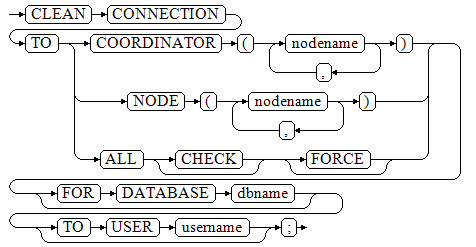CLEAN CONNECTION
Description
Clears database connections. You may use this statement to delete a specific user's connections to a specified database.
Precautions
- GaussDB does not support specified nodes and supports only TO ALL.
- This function can be used to clear the normal connections that are being used only in force mode.
- The CLEAN CONNECTION statement with the DATABASE option specified cannot be executed in a PDB.
Syntax
CLEAN CONNECTION
TO { COORDINATOR ( nodename [, ... ] ) | NODE ( nodename [, ... ] )| ALL [ CHECK ] [ FORCE ] }
[ FOR DATABASE dbname ]
[ TO USER username ];

Parameters
- CHECK
This parameter can be specified only when the node list is specified as TO ALL. Setting this parameter will check whether a database is accessed by other sessions before its connections are cleared. If any sessions are detected before DROP DATABASE is executed, an error will be reported and the database will not be deleted.
- FORCE
This parameter can be specified only when the node list is specified as TO ALL. Setting this parameter will send SIGTERM signals to all the threads related to the specified dbname and username and forcibly shut them down.
- COORDINATOR ( nodename [, ... ] ) | NODE ( nodename [, ... ] ) | ALL
Only TO ALL is supported. This parameter must be specified. All specified connections on the node will be deleted.
- dbname
Deletes connections to a specified database. If this parameter is not specified, connections to all databases will be deleted.
Value range: an existing database name
- username
Deletes connections of a specific user. If this parameter is not specified, connections of all users will be deleted.
Value range: an existing username
Examples
1 2 3 4 5 6 7 8 9 10 11 12 13 14 15 16 17 18 19 20 21 22 23 24 25 26 27 28 29 30 31 32 33 34 35 36 37 38 |
-- Create the test_clean_connection database. gaussdb=#CREATE DATABASE test_clean_connection; -- Create user jack. gaussdb=#CREATE USER jack PASSWORD '********'; -- Log in to the database as the user jack in another session, and query the connection information in the view. gaussdb=#SELECT datname,usename,application_name,waiting,state FROM pg_stat_activity WHERE datname = 'test_clean_connection'; datname | usename | application_name | waiting | state -----------------------+---------+------------------+---------+------- test_clean_connection | jack | gsql | f | idle (1 row) -- If you directly delete the test_clean_connection database, the following error information is displayed: gaussdb=#DROP DATABASE test_clean_connection; ERROR: Database "test_clean_connection" is being accessed by other users. You can stop all connections by command: "clean connection to all force for database XXXX;" or wait for the sessions to end by querying view: "pg_stat_activity". DETAIL: There is 1 other session using the database. -- Delete the connections to all nodes for logging in to the test_clean_connection database. -- If the FORCE parameter is not used, connections in other states cannot be deleted. gaussdb=#CLEAN CONNECTION TO ALL FORCE FOR DATABASE test_clean_connection; -- Query the connection for logging in to the test_clean_connection database. gaussdb=#SELECT datname,usename,application_name,waiting,state FROM pg_stat_activity WHERE datname = 'test_clean_connection'; datname | usename | application_name | waiting | state ---------+---------+------------------+---------+------- (0 rows) -- Delete the test_clean_connection database. gaussdb=#DROP DATABASE test_clean_connection; -- Delete user jack. gaussdb=#DROP USER jack; |
Feedback
Was this page helpful?
Provide feedbackThank you very much for your feedback. We will continue working to improve the documentation.See the reply and handling status in My Cloud VOC.
For any further questions, feel free to contact us through the chatbot.
Chatbot





